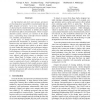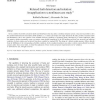118 search results - page 1 / 24 » Design and Evaluation of Hybrid Fault-Detection Systems |
ISCA
2005
IEEE
13 years 11 months ago
2005
IEEE
As chip densities and clock rates increase, processors are becoming more susceptible to transient faults that can affect program correctness. Up to now, system designers have prim...
IPPS
2007
IEEE
13 years 11 months ago
2007
IEEE
Model checking, logging, debugging, and checkpointing/recovery are great tools to identify bugs in small sequential programs. The direct application of these techniques to the dom...
AUTOMATICA
2006
13 years 5 months ago
2006
Given a number of possibly concurrent faults (and disturbances) that may affect a nonlinear dynamic system, it may not be possible to solve the standard fault detection and isolat...
ISCA
2000
IEEE
13 years 9 months ago
2000
IEEE
Smaller feature sizes, reduced voltage levels, higher transistor counts, and reduced noise margins make future generations of microprocessors increasingly prone to transient hardw...
EDCC
2006
Springer
13 years 9 months ago
2006
Springer
The importance of fault tolerance at the processor architecture level has been made increasingly important due to rapid advancements in the design and usage of high performance de...


